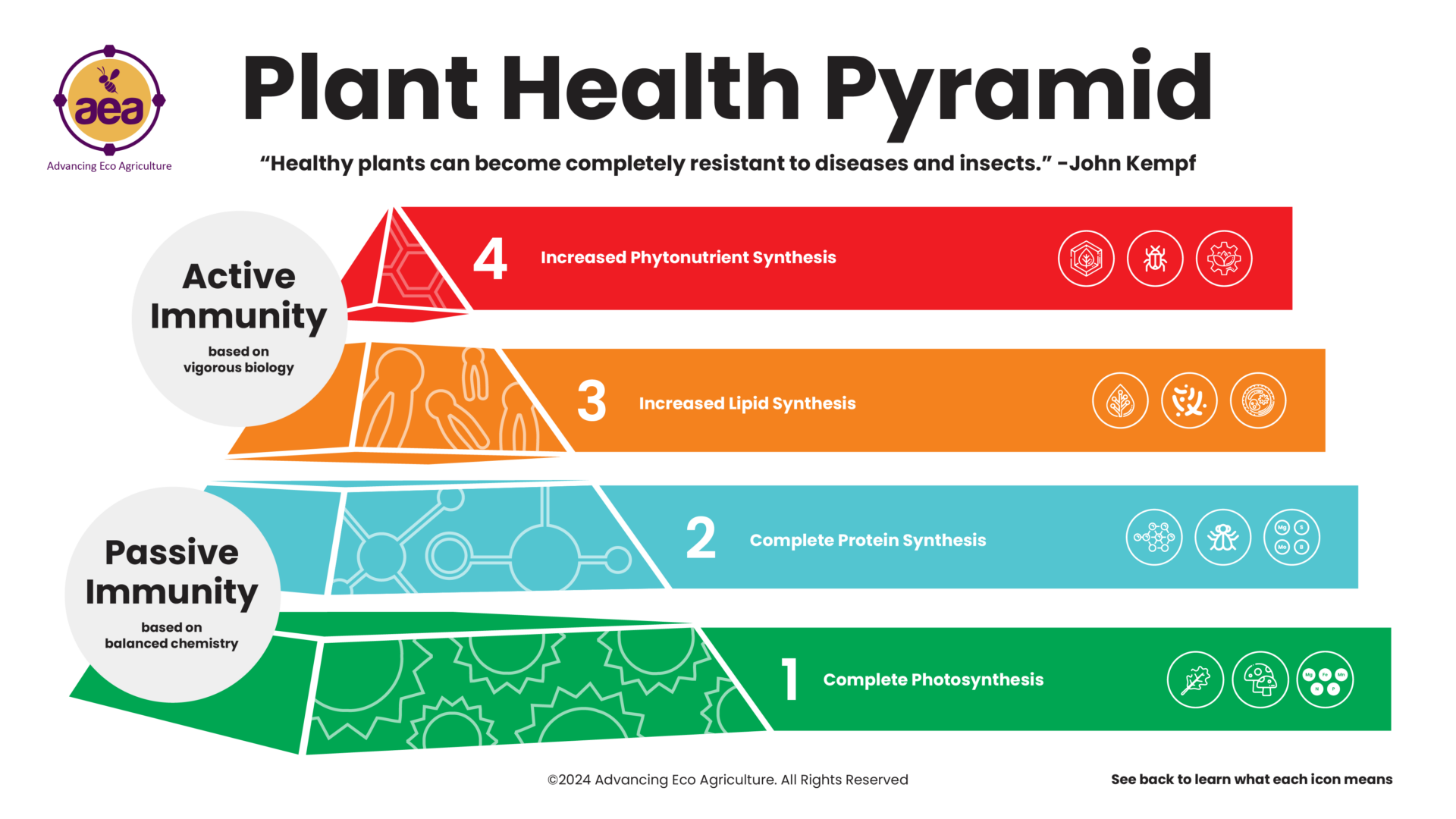In the last two weeks, we covered the first two levels of John Kempf’s Plant Health Pyramid, in which balanced mineral nutrition in plants gives them resistance to soil-borne pathogens and simple insects.
Levels 1 and 2 involve passive immunity: by removing the pest’s food source, they remove any incentive for the pests to bother the plants. By contrast, levels 3 and 4 develop pest and disease resistance through active immunity: they activate the plant’s immune system and physical defenses so it can defend itself against attacking pests.
The first two levels are achieved simply by balanced chemistry within the plant, but levels 3 and 4 are more advanced because they depend on soil biology.
For these two reasons, there is a gap between levels 2 and 3. From a management perspective, the grower must focus their attention on creating thriving soil biology. It should be noted that Levels 1 and 2 must be attained before the plant can move onward: without complete photosynthesis and protein synthesis, the plant won’t enough energy to produce the complex compounds of levels 3 and 4.
Now let’s dive in to Level 3.

Level 3: Lipid Synthesis
In level 3, plants produce so much energy that they have a surplus. Just like humans, plants store their surplus energy as fat. Plants at level 3 see at 2-4x increase in lipid synthesis. To get specific, plants before this level have a lipid concentration of 1.5-2% (on a dry matter basis). Plants at level 3 have lipid concentrations of 4-6%.
And just like humans, plants find a place in their bodies to store the fat. Since plants don’t have the handy fat storage containers of thighs, hips, and bellies that humans have, they find somewhere else to store fat: their leaves. Plants at level 3 will have glossy or waxy leaves on account of the fat stored on their surfaces.

Disease resistance
That waxy layer on the leaves actually serves a critical function for the plant’s immune system: it becomes an impenetrable shield that prevents airborne pathogens from infecting the plant when they land on its leaves.
These types of pathogens can be either fungal or bacterial and include such common nuisances as:
- downy mildew
- powdery mildew
- fire blight
- late blight
- rust
- bacterial speck
These pathogens work by using a pectolytic enzyme to break down pectins in the cell membrane, which allows them to invade the cell and use it as an energy source. The waxes on the leaf’s surface prevent that enzyme from working, so the pathogens are unable to enter the plant’s cells and cause an infection.

Microbial metabolites
To reach this stage of health, plants must absorb the majority of their nutrition from soil microbes. The microbial metabolites produced in the soil tend to be more complex forms of nutrition, which means that the plant doesn’t need to spend any energy converting simple forms of nutrition into those more complex forms.
For example, when corn absorbs 80% of its nitrogen in the from of nitrate, it uses 16% of its total energy supply just converting that nitrate into amino acids. But soil microbes can create whole amino acids. If the plant instead absorbs its nitrogen as microbe-produced amino acids, that means 16% of its energy is freed up for other uses. When it has enough excess energy, it starts storing it as fat, and Level 3 begins.
Plants are capable of absorbing relatively complex compounds from the soil profile. John Kempf calls these “prefabricated parts,” and they save the plant a tremendous amount of energy.
Next we’ll cover the final level of the Plant Health Pyramid, in which the soil microbiome helps plants become resistant to beetles and nematodes.
Subscribe to get each blog post to your inbox.
You'll get each post to your inbox (~1x/week).
You may unsubscribe at any time. We value your personal information. Here's our Privacy Policy.
"*" indicates required fields



